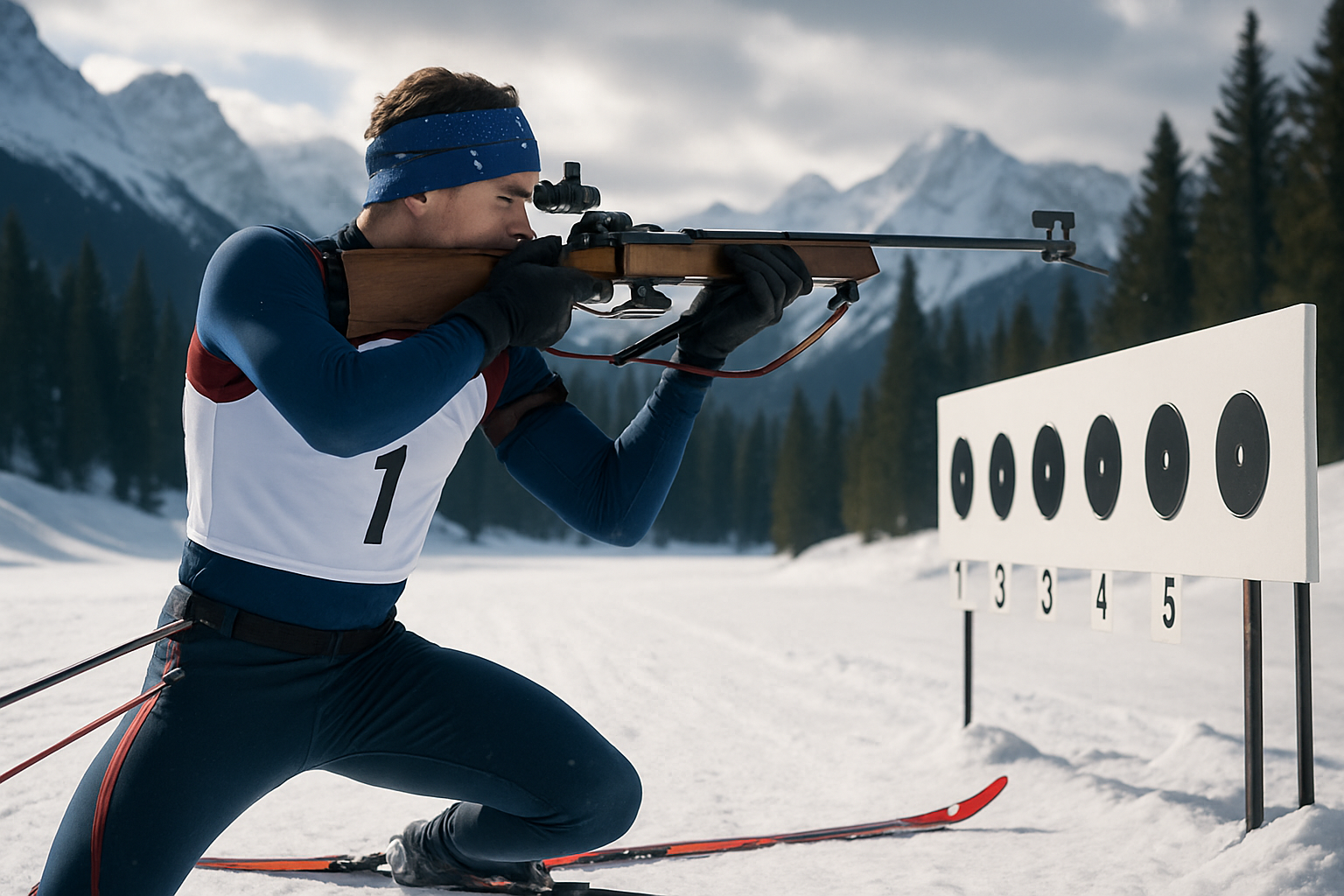Biathlon: The Fusion of Endurance and Precision
In the realm of winter sports, one discipline stands out for its unique combination of physical endurance and mental precision. Biathlon, a captivating blend of cross-country skiing and rifle marksmanship, challenges athletes to push their cardiovascular limits while maintaining the focus and steadiness required for accurate shooting. This sport, often overlooked in mainstream media, offers a fascinating study in human performance and the delicate balance between intensity and control.

The Origins and Evolution of Biathlon
Biathlon’s roots stretch deep into history, intertwining with the cultural practices of northern communities. The earliest known depictions of humans hunting on skis date back to rock carvings in Norway from over 4,000 years ago. These ancient hunters recognized the efficiency of combining skiing with hunting, a practice that would eventually evolve into the modern sport we know today.
The transition from survival skill to organized competition began in the 18th century with European military patrols. These ski-equipped units would traverse vast snowy terrains, often engaging in combat situations that required both speed on skis and accuracy with firearms. The Norwegian military organized the first known biathlon competition in 1767, setting the stage for future developments.
As the sport gained recognition, it began to appear in various international competitions. The first World Championship for biathlon was held in 1958 in Austria, marking a significant milestone in its journey to becoming a globally recognized sport. The Olympic debut of biathlon came in 1960 at the Squaw Valley Winter Games, though initially only as a men’s event. It wasn’t until 1992 that women’s biathlon was introduced at the Olympics, reflecting the sport’s growing inclusivity and appeal.
Over the decades, biathlon has undergone numerous changes in equipment, course design, and competition formats. The introduction of electronic targets in the 1980s revolutionized the sport, allowing for more accurate scoring and enhancing the spectator experience. Today’s biathlon rifles are highly sophisticated, custom-made for each athlete to ensure maximum accuracy and reliability in extreme conditions.
The Physical Demands of Biathlon
Biathlon is arguably one of the most physically demanding winter sports, requiring athletes to possess an extraordinary level of cardiovascular fitness combined with the ability to rapidly transition between high-intensity skiing and precise, controlled shooting. The cross-country skiing portion of biathlon is an all-out aerobic effort, with competitors reaching heart rates of up to 90% of their maximum during the race.
The skiing technique used in biathlon is predominantly the skating style, which allows for greater speed compared to the classic cross-country technique. This high-energy skating motion engages virtually every major muscle group in the body, from the powerful leg muscles driving the skis forward to the core and upper body providing balance and propulsion through the pole plants.
Athletes must navigate varied terrain, including uphills, downhills, and flat sections, each requiring different technical approaches and energy management strategies. The ability to maintain an efficient skiing form while under extreme physical stress is crucial, as any wasted energy can mean the difference between victory and defeat.
The cardiovascular system of a biathlete is highly adapted to sustain prolonged periods of intense exercise. Research has shown that elite biathletes have exceptionally high VO2 max values, often exceeding 80 ml/kg/min in men and 70 ml/kg/min in women. These values are comparable to those of world-class cross-country skiers and indicate the incredible aerobic capacity required for success in the sport.
Marksmanship: The Art of Precision Under Pressure
While the skiing component of biathlon tests an athlete’s endurance and speed, the shooting element introduces a completely different set of challenges. Biathletes must quickly transition from the high-intensity aerobic activity of skiing to a state of calm focus required for accurate shooting. This rapid shift in physical and mental states is often described as one of the most difficult aspects of the sport.
The shooting portion of biathlon takes place on a 50-meter range, where athletes must hit five targets in either a prone (lying down) or standing position. The targets are relatively small, measuring just 45mm in diameter for prone shooting and 115mm for standing. Missing a target results in either a time penalty or additional distance that must be skied, making accuracy crucial for competitive success.
The physiological changes that occur during the transition from skiing to shooting are profound. As athletes approach the shooting range, they must quickly lower their heart rate and control their breathing to stabilize their aim. Studies have shown that elite biathletes can reduce their heart rate by up to 40 beats per minute in the approach to shooting, a skill that requires years of training and mental conditioning.
Proper shooting technique in biathlon involves a complex interplay of body positioning, breath control, and trigger manipulation. In the prone position, athletes must quickly settle into a stable stance, aligning their body and rifle for maximum stability. The standing position presents even greater challenges, requiring exceptional core strength and balance to maintain a steady aim.
Training Methodologies for Biathlon Excellence
The unique demands of biathlon require a multifaceted training approach that addresses both the endurance and precision aspects of the sport. Coaches and athletes employ a variety of methods to develop the physical and mental skills necessary for success.
Endurance training forms the foundation of a biathlete’s regimen. This typically involves a combination of long, slow-distance training to build aerobic capacity and high-intensity interval training to improve lactate threshold and VO2 max. Cross-country skiing remains the primary mode of training, but athletes also incorporate roller skiing, running, and cycling to maintain fitness year-round.
Strength training plays a crucial role in biathlon performance. Athletes focus on exercises that enhance skiing power and technique, such as plyometrics, weightlifting, and sport-specific movements. Core strength is particularly emphasized, as it contributes to both skiing efficiency and shooting stability.
Shooting practice is, of course, a daily part of a biathlete’s routine. This includes dry-firing (practicing without ammunition) to perfect technique and live-fire training under various conditions to simulate race scenarios. Many athletes use biofeedback devices to monitor their heart rate and breathing patterns during shooting, helping them develop strategies for rapid physiological control.
Mental training is perhaps equally important as physical preparation in biathlon. Athletes work with sports psychologists to develop techniques for managing stress, maintaining focus, and making quick decisions under pressure. Visualization exercises are commonly used to mentally rehearse race strategies and shooting sequences.
The Psychology of Biathlon: Mental Toughness and Focus
The mental aspect of biathlon cannot be overstated. The sport demands an exceptional level of psychological resilience and the ability to maintain focus under extreme physical and emotional stress. The constant shift between high-intensity skiing and precision shooting creates a unique mental challenge that few other sports can match.
One of the key psychological skills in biathlon is the ability to compartmentalize. Athletes must be able to quickly switch their mental focus from the all-out effort of skiing to the calm, controlled state required for accurate shooting. This rapid cognitive shift, often referred to as “changing gears,” is a skill that takes years to master.
Anxiety management is another critical psychological component of biathlon performance. The pressure of competition, combined with the knowledge that a single missed shot can dramatically impact the outcome, can create intense anxiety. Successful biathletes develop strategies to manage this stress, often using techniques such as controlled breathing, positive self-talk, and mindfulness practices.
Decision-making under fatigue is a constant challenge in biathlon. As athletes approach the shooting range, they must quickly assess their physical state, wind conditions, and tactical situation to make split-second decisions about shooting rhythm and technique. This ability to process information and make sound judgments while physically exhausted is a hallmark of elite biathletes.
Research in sports psychology has shown that biathletes often exhibit high levels of mental toughness and resilience. These traits allow them to maintain performance in the face of adversity, such as poor weather conditions or equipment malfunctions. The unpredictable nature of biathlon, where a seemingly secure lead can vanish with a single missed shot, requires athletes to develop a mindset of adaptability and perseverance.
Equipment Innovations and Their Impact on Performance
The evolution of biathlon equipment has played a significant role in the sport’s development and the ever-improving performances of its athletes. From skis and rifles to clothing and ammunition, every aspect of a biathlete’s gear is carefully engineered to maximize performance and reliability in challenging conditions.
Biathlon rifles have seen perhaps the most dramatic advancements. Modern competition rifles are custom-made for each athlete, taking into account their physical dimensions, shooting style, and personal preferences. These rifles are incredibly precise, capable of consistently hitting targets at 50 meters even in windy conditions. The triggers are highly sensitive, often requiring less than 100 grams of pressure to fire, allowing for rapid and accurate shooting.
Ammunition for biathlon is specially designed to maintain accuracy in cold temperatures and high altitudes. The .22 caliber rounds used in competition are selected for their consistency and low recoil, enabling athletes to maintain their shooting position through multiple shots.
Ski technology has also evolved significantly, with manufacturers developing materials and designs that optimize glide and grip for the varied conditions encountered in biathlon. The introduction of fluorinated waxes revolutionized ski preparation, though recent environmental concerns have led to restrictions on their use in some competitions.
Clothing innovations have focused on balancing thermal regulation with freedom of movement. Modern biathlon suits are designed to provide warmth during the skiing portions while allowing for rapid cooling as athletes approach the shooting range. Some suits even incorporate special panels that help stabilize the athlete’s position during shooting.
The introduction of electronic targets in biathlon has not only improved scoring accuracy but has also enhanced the spectator experience. These targets provide instant feedback to both athletes and audience, adding to the excitement and drama of the competition.
Biathlon on the World Stage: Competitions and Championships
Biathlon has grown into a globally recognized sport with a dedicated following, particularly in Europe where it enjoys immense popularity. The International Biathlon Union (IBU) oversees the sport’s major competitions, including the Biathlon World Cup circuit and the Biathlon World Championships.
The Biathlon World Cup is a series of races held throughout the winter season at various locations across Europe and North America. Athletes accumulate points based on their performances in these races, with the overall World Cup winner crowned at the end of the season. The variety of race formats in the World Cup series showcases the versatility required of top biathletes.
The Biathlon World Championships, held annually except in Olympic years, is the pinnacle of the sport outside of the Winter Olympics. These championships feature individual, sprint, pursuit, mass start, and relay events for both men and women. The atmosphere at World Championships is electric, with tens of thousands of spectators often braving frigid conditions to witness the drama unfold.
At the Olympic level, biathlon has grown to become one of the most-watched winter sports. The Olympic program now includes 11 biathlon events, showcasing the sport’s various formats and gender equality. The inclusion of mixed relay events has added an extra dimension of excitement and national pride to the Olympic biathlon competition.
The dominance of certain nations in biathlon has shifted over the years. While Scandinavian countries, particularly Norway, have historically been powerhouses in the sport, nations like Germany, France, and Russia have also produced numerous champions. In recent years, athletes from countries not traditionally associated with winter sports, such as Italy and the Czech Republic, have made significant impacts on the international stage.
The Future of Biathlon: Challenges and Opportunities
As biathlon continues to evolve, it faces both challenges and opportunities that will shape its future. One of the most pressing issues is the impact of climate change on winter sports. Rising global temperatures and unpredictable weather patterns pose significant challenges for biathlon organizers, who must ensure consistent and fair conditions for competitions.
Efforts are underway to make biathlon more environmentally sustainable. This includes the development of artificial snow technologies that use less water and energy, as well as the exploration of alternative venues that can reliably host competitions in a changing climate. Some organizers are even experimenting with indoor biathlon facilities, though these remain controversial among purists who value the sport’s connection to nature.
Another challenge facing biathlon is the need to expand its global appeal. While the sport enjoys immense popularity in Europe, it remains relatively unknown in many parts of the world. Initiatives to introduce biathlon to new markets, particularly in Asia and North America, are ongoing. These efforts include youth development programs, exhibition events, and media partnerships to increase visibility.
Technological advancements continue to shape the sport. The potential integration of augmented reality in spectator experiences, for example, could revolutionize how fans engage with biathlon competitions. Imagine viewing a race through smart glasses that display real-time data on athlete performance, heart rates, and shooting accuracy.
The ongoing debate over doping in sports also affects biathlon. The sport has had its share of controversies, leading to increased efforts in anti-doping education and testing. Maintaining the integrity of competition remains a top priority for biathlon’s governing bodies.
On the positive side, biathlon’s unique combination of endurance and precision makes it an excellent platform for studying human performance. Research in areas such as physiological adaptation, cognitive function under stress, and the limits of human endurance often draws insights from biathlon athletes. This scientific interest not only benefits the sport but contributes to our broader understanding of human capabilities.
The Biathlete’s Journey: From Novice to Elite
The path to becoming an elite biathlete is long and demanding, typically beginning in childhood and requiring years of dedicated training. Many successful biathletes start their athletic careers in either cross-country skiing or target shooting before combining the two disciplines.
Young athletes are often introduced to biathlon through youth programs that focus on developing fundamental skills in both skiing and marksmanship. These programs emphasize safety, sportsmanship, and the enjoyment of outdoor winter activities. As children progress, they begin to participate in age-group competitions that simulate the format of adult races but with modified distances and shooting requirements.
The teenage years are critical for biathlon development. This is when aspiring athletes start to specialize, increasing their training volume and intensity. Many join specialized sports schools or academies that allow them to balance academic studies with rigorous athletic training. It’s during this period that young biathletes begin to master the complex skill of transitioning between skiing and shooting.
The transition from junior to senior competition is a significant challenge in a biathlete’s career. The increased race distances and higher level of competition require athletes to further refine their skills and adapt to the demands of elite-level performance. Many biathletes spend several years competing at the IBU Cup level, the second-tier international circuit, before breaking through to the World Cup.
Becoming a world-class biathlete requires not only physical talent and mental fortitude but also access to resources. Elite training facilities, specialized coaching, high-quality equipment, and sports science support are essential for success at the highest level. National biathlon federations play a crucial role in identifying and developing talent, often providing financial support and training opportunities for promising athletes.
The life of an elite biathlete is one of constant travel, training, and competition. The World Cup circuit takes athletes across Europe and North America for several months each winter, requiring careful planning and recovery strategies to maintain peak performance throughout the season. Off-season training is equally demanding, with athletes logging hundreds of hours on roller skis, running trails, and shooting ranges to prepare for the next competitive season.
The Cultural Impact of Biathlon
Beyond its status as a competitive sport, biathlon has had a significant cultural impact, particularly in countries where it enjoys widespread popularity. In nations like Norway, Germany, and Russia, biathlon stars are celebrated as national heroes, their performances captivating millions of television viewers during the winter months.
The sport’s popularity has led to the development of biathlon tourism, with fans traveling to witness major competitions and experience the unique atmosphere of a World Cup or World Championship event. Host venues often become hubs of cultural exchange, as spectators from various countries gather to celebrate their shared passion for the sport.
Biathlon has also inspired various forms of media and entertainment. Documentaries exploring the lives of top athletes, video games simulating the biathlon experience, and even fiction novels set in the world of competitive biathlon have all contributed to the sport’s cultural footprint.
In some regions, particularly in Scandinavia and the Alps, biathlon has influenced local economies and community development. Training centers and competition venues create job opportunities and attract tourism, while also promoting outdoor recreation and healthy lifestyles among local populations.
The values embodied by biathlon – endurance, precision, mental toughness, and the ability to perform under pressure – have made it an attractive sport for corporate sponsorship and team-building activities. Many companies use biathlon-inspired challenges in their employee development programs, recognizing the parallels between the sport’s demands and the skills valued in the business world.
Biathlon’s Contribution to Sports Science and Human Performance
The unique nature of biathlon, combining intense cardiovascular exercise with fine motor control, has made it a fascinating subject for sports scientists and researchers in human performance. Studies on biathletes have provided valuable insights into areas such as cardiorespiratory adaptation, thermoregulation, and cognitive function under physical stress.
One area of particular interest is the physiological transition between skiing and shooting. Researchers have examined how elite biathletes are able to rapidly lower their heart rates and stabilize their breathing as they approach the shooting range. This ability to quickly shift from a state of high arousal to one of calm focus has implications beyond sport, potentially informing strategies for performance in high-stress occupations such as emergency response or military operations.
The impact of cold environments on human performance is another key area of study in biathlon. Athletes must maintain precise motor control in fingers and hands while operating in sub-zero temperatures, often for extended periods. Research on how biathletes adapt to these conditions has contributed to our understanding of cold weather physiology and the development of protective gear for various cold-weather activities.
Cognitive performance under fatigue is a critical aspect of biathlon success. Studies have





